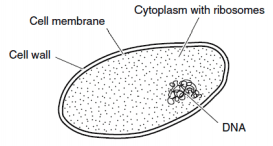
4A Prokaryotic and Eukaryotic Cells Review
Quiz by Amanda Jones
High School
Biology(2017)(ARCHIVED)
Texas Essential Knowledge and Skills (TEKS)
Feel free to use or edit a copy
includes Teacher and Student dashboards
Measures 1 skill from
Measures 1 skill from
Track each student's skills and progress in your Mastery dashboards
With a free account, teachers can
- edit the questions
- save a copy for later
- start a class game
- automatically assign follow-up activities based on students’ scores
- assign as homework
- share a link with colleagues
- print as a bubble sheet
10 questions
Show answers
- Q1How is the prokaryotic bacterium in the diagram different from a eukaryotic cell?It stores its genetic information in DNA.It has a cell membrane.It has no membrane-bound nucleus.It has ribosomes to make proteins.30sBIOL.4a
- Q2Which of the following organelles is present in both prokaryotes and eukaryotes?RibosomeNucleusGolgi bodyEndoplasmic reticulum30sBIOL.4a
- Q3Which characteristic of prokaryotic organisms makes them different from eukaryotes?Prokaryotes have DNAProkaryotes do not have chromosomes.Prokaryotes are made of cells.Prokaryotic cells do not have membrane-bound organelles.30sBIOL.4a
- Q4Both euglena and cyanobacteria are photosynthetic unicellular organisms found in pond water. The feature that distinguishes euglena from cyanobacteria is the —presence of ribosomesability to reproducepresence of a nuclear membraneability to maintain homeostasis30sBIOL.4a
- Q5A single prokaryotic cell can divide several times in an hour. Few eukaryotic cells can divide as quickly. Which of the following statements best explains this difference?Eukaryotic cells are smaller than prokaryotic cells.Eukaryotic cells have less DNA than prokaryotic cells.Eukaryotic cells are more structurally complex than prokaryotic cells.Eukaryotic cells have more cell walls than prokaryotic cells.30sBIOL.4a
- Q6A biologist looks at an organism through a microscope. Which of the following observations tells the biologist that the organism is eukaryotic?The organism has a cell membrane.The organism moves with flagella.The organism is unicellular.The organism has membrane-bound organelles.30sBIOL.4a
- Q7The diagram represents Trichodina. Trichodina is a eukaryotic organism that attaches itself to fish and eats bacteria. Which of the following distinguishes Trichodina from all prokaryotes?Trichodina has a nucleusTrichodina is unicellular.Trichodina is heterotrophic.Trichodina has cytoplasm.30sBIOL.4a
- Q8A lab technician needs to determine whether cells in a test tube are prokaryotic or eukaryotic. The technician has several dyes she could use to stain the cells. Four of the dyes are described in the table below. Which dye could the technician use to determine whether the cells are prokaryotic or eukaryotic?eosinacridine orangeosmium tetroxideNile blue30sBIOL.4a
- Q9Which of the following sets of organelles can be found in both eukaryotes and prokaryotes?chloroplast and mitochondriaGolgi body and vacuolesribosomes and cell membranenucleus and mitochondria30sBIOL.4a
- Q10Some students used information they gathered from lab investigations to prepare a table. They entered the table in their lab notebooks. Which of these correctly identifies the two cells described in the table?Cell 1 is eukaryotic, and Cell 2 is prokaryotic.Both Cell 1 and Cell 2 are eukaryotic.Cell 1 is prokaryotic, and Cell 2 is eukaryotic.Both Cell 1 and Cell 2 are prokaryotic.30sBIOL.4a
